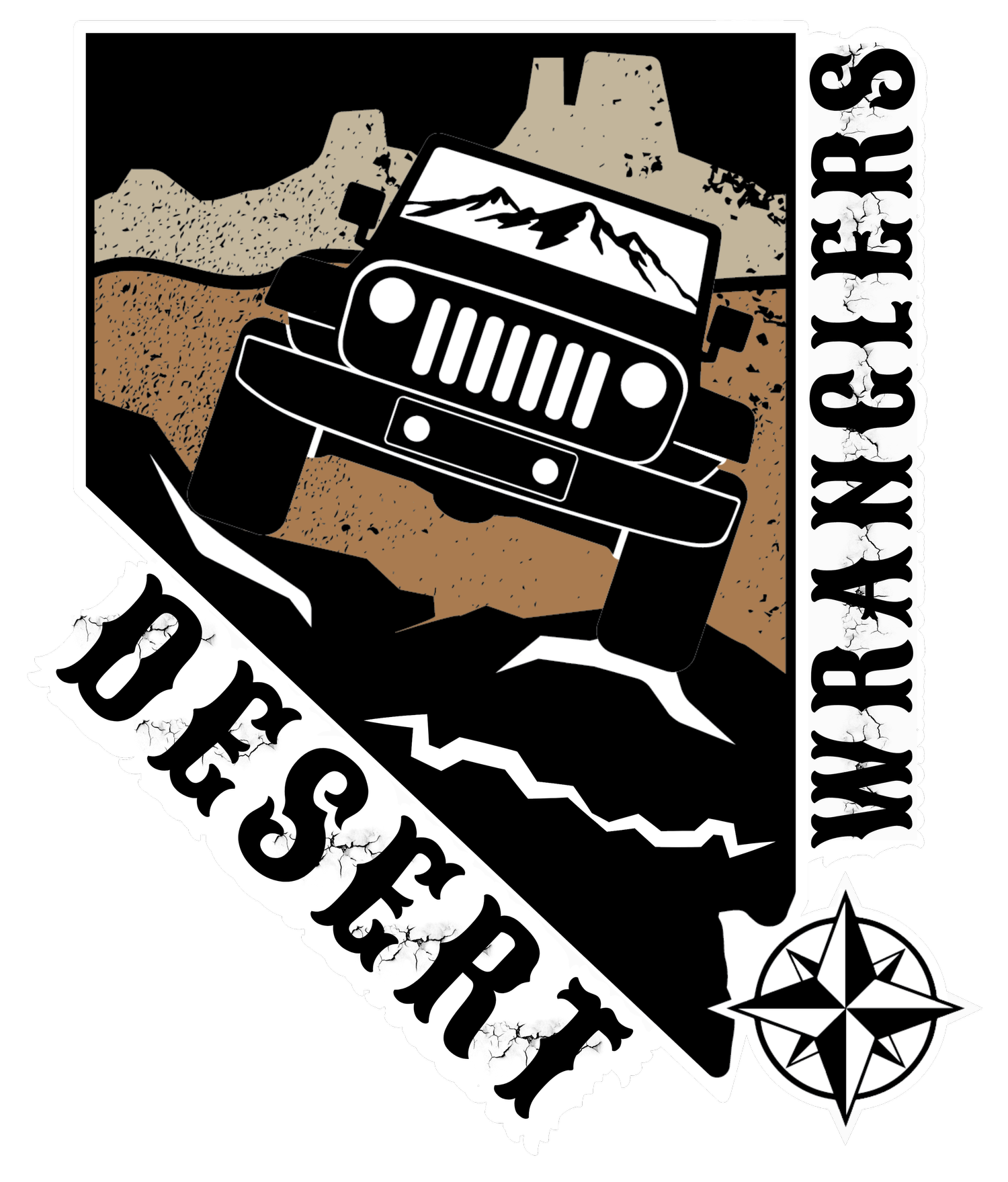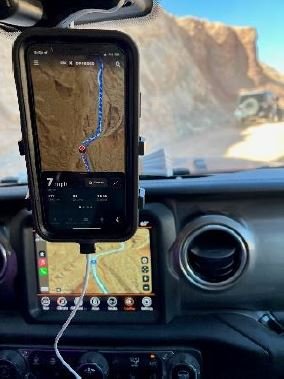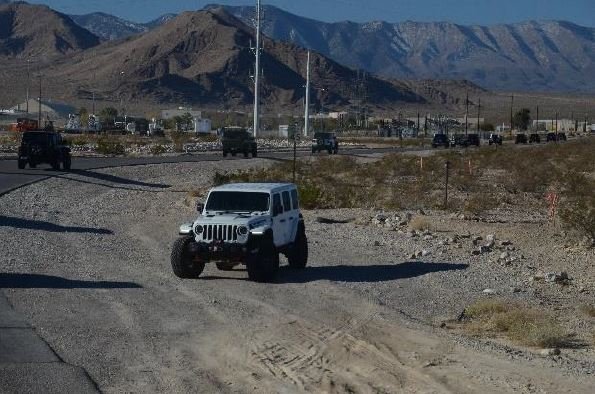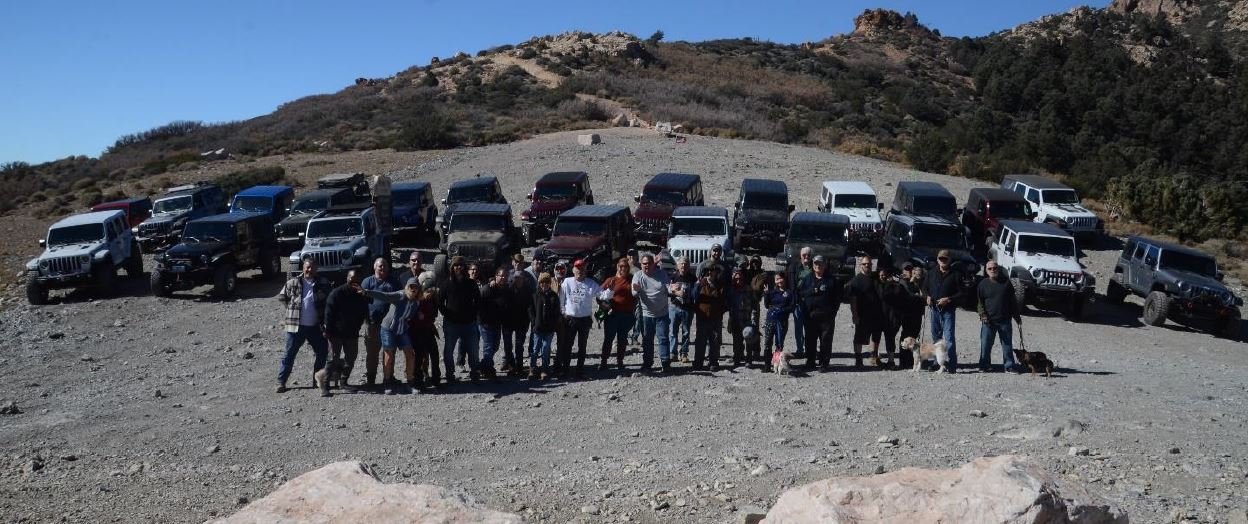Off-Road 101
Anatomy of Desert Wranglers Trail Runs
By Fred Ginsburg
OUR FIRST OFF-ROAD 101 CLASS IS COMING UP MAR 25th - RESERVE YOUR SPOT BEFORE ITS FILLED UP!
Here is a brief explanation about how Desert Wranglers organizes our trail runs. If you have been on any of our runs, then most of this is not new. But if you are just getting started in off-roading, this will describe how we run things.
Every trail run is arranged and led by a Trail Leader, specific to that particular run. Overseeing the Trail Leaders in general, but usually not present on the run, is our Trail Master.
PRE-RUNS
When a run is proposed by a Trail Leader, unless that trail has been recently driven by that Leader – the first step is for the Leader (accompanied by at least one other jeep) to PRE-RUN the trail to map out or verify the track (aka route), record an up to date .gpx file, and to check for any deterioration of road conditions or new obstacles that may have recently occurred due to weather events such as major rain storms/flash flooding.
Sometimes, what used to be a fairly easy trail can become much more challenging as a result of recent weather activity. So it is extremely important to pre-run all of our trails at least a few days ahead of time.
Every now and then, you may see a posting inviting a few jeepers to go along on a PRE-RUN. Before you rush and sign up, bear in mind that you might encounter unforeseen obstacles and detours. If we knew what was out there, it wouldn’t be a pre-run. Pre-runs are not for stock vehicles nor for inexperienced drivers, since no one is completely sure what may be encountered.
POSTING OF TRAIL RUNS
Desert Wranglers trail runs are posted on our main website as well as in our Meetup Events section.
Sometimes, we will go ahead and schedule a run pending the results of the pre-run. Then, depending on the outcome of the pre-run, we might possibly need to alter the description or be forced to cancel the run altogether.
We try to make our descriptions as detailed as we can, so that you are aware of what to expect. Trail Leaders will say if this trail is “Wrangler stock friendly” or if larger tires, lifts, etc. are strongly recommended. Although most of our trail runs are beginner/intermediate friendly, occasionally we do schedule a few, more difficult runs (rock crawling). It is very important for you to READ the descriptions carefully. Contact the Trail Leader if you are unsure about the difficulty level.
Trail runs may be scheduled on weekdays as well as weekends. The day and date is up to the Trail Leader. We all have different personal schedules and availability, so we offer trail runs on a variety of days.
The end time of a run is never guaranteed. The end time is typically an estimate from how long the pre-run took or prior runs of the trail.
However, there are many variables that affect the end time, such as the total number of jeeps (stopping at each obstacle so that we clear them one jeep at a time), other jeeps we might encounter also on the trail, individual driving skills, additional stops, recovery of stuck vehicles (such as sand), and much more.
You should anticipate the run taking the entire day and not have other commitments for that day, as it will not be possible to leave the run early.
BEGINNER 101 TRAIL RUNS
Some of the Desert Wrangler runs will be labeled as BEGINNER 101 runs. These runs are intended for, but not limited to, first time off-roaders.
However, BEGINNER 101 does not mean that these are the easiest rated trails; rather, they are chosen as confidence builders and to expose new off-roaders to a variety of terrain and small obstacles.
Your trail leaders will advise and coach you. They will assist you with airing down/up; understanding how and when to shift from 2H/4H/4L; hill ascents/descents; and other situations that the group may encounter.
We want your first off-road experience to be fun as well as educational.
HOW TO SIGN UP FOR A TRAIL RUN
All of our trail runs are posted under Events on our Meetup site.
Although the date and short trail descriptions may be openly posted on our website and Meetup sites, the exact rendezvous place & time are withheld from public view.
To see that information, along with more detailed description, you must SIGN IN to our private Meetup page. When you join Desert Wranglers on our main website (www.desertwranglers.club), you actually are taken to our Meetup Pro software in order to process your membership application & dues, so it recognizes if you are an Active Member.
Trail runs are limited to specific numbers of vehicles, depending on the particular trail (usually around ten or so, but sometimes up to 20). Therefore, we require that you RSVP in Meetup for each trail run. When the run is filled up, Meetup will create a WAIT LIST in case of cancellations.
Please note that your RSVP is per Jeep, not per passenger.
You may not RSVP for other vehicles; or for non-members’ vehicles. If a friend is visiting, then they are welcome to ride along in your Jeep.
If there is a special situation, you should contact the Trail Leader and discuss it.
When you reserve a slot on a trail run, you are preventing another club member from participating – so please be courteous and only RSVP if you are sure about attending. In the event that you do need to cancel, please edit your RSVP immediately so that someone else can take your place.
Desert Wranglers does keep track of last minute cancellations and no-shows; and repeated unexcused absences may result in loss of privileges or club expulsion.
RENDEVOUS and DRIVERS BRIEF
You should arrive at least 20 minutes before the scheduled departure time shown on the event posting. Example: for an 08:00 am run, plan to arrive no later than 07:40 so that you have time to fuel up and to visit the restroom.
Always begin a trail run with a full tank of gas, even though you may only need a fraction of it to complete the run. But should you become stranded, a full tank means that you can run your engine hours longer for heat, AC, light, etc.
Wear the proper attire for the climate you will be exploring. We strongly recommend closed toe shoes or hiking boots and long pants – in case you have to walk more than 10 feet from your jeep! Nevada desert means leg scratching cactus, crawly things, lots of stones. You should also think about protective sun gear. Throw some cold weather clothing in the back, because it can get pretty chilly out there, especially during the colder months and at night.
Bring lots of water to stay hydrated. And some snacks, too.
Prior to the departure time, the Trail Leader will hold a drivers meeting.
Turn in your signed liability waiver (including all passengers). Waivers can be downloaded from our main website; or ask for one when you arrive. We require newly signed waivers for every trail run, even if you have turned them in on previous runs since the dates, passenger names, and emergency contact need to be up to date. Plus, the Trail Leader cannot access stored data should it be immediately required.
During the drivers meeting, the Trail Leader will discuss the planned route, obstacles, points of interest, and the general plan.
Desert Wranglers uses GMRS radios for communication. If you do not have a working radio, ask. Usually, the Trail Leaders or the Gunners bring spares.
Make sure that you have a full size, functional spare off-road tire. Although fellow jeepers can help you out with muscle, tools, etc. – you need to bring your own tire. And don’t forget the special adapter (key) if you have locking lugnuts!
If there are more than a handful of jeeps in your group, you might be assigned a “slot number” which will be your place in the caravan as well as your “call sign” identifier.
Whenever the group rolls out in a single column, it is important to stay in order and also to allow the Mid-Gunner to insert into the appropriate slot. If you need to comment on your radio about anything trail related, use your number to identify yourself so that others in the column know your relative position. Example: “This is jeep five. Stay to the right of the big notch, there is enough room to avoid it.”
HEADING OUT
The group will roll out from the rendezvous in a single column. Join the caravan in the prescribed order; the Tail Gunner will call out numbers so that jeeps join the caravan properly.
The lead group will stay to the side of the road, and slow down or stop, until the whole line of jeeps has made the turns or cleared the stop lights. Mid-Gunner and Tail Gunner will broadcast their status to the Leader.
The caravan will continue to the trailhead.
AIR DOWN
A short ways into the trail, the Leader will have the group pull over at a safe area and stop. It is time to air down (deflate) all of your tires to approximately 15 psi.
If this is your first time, other jeepers will assist you. If you lack the proper deflation hardware, they will use theirs and explain its function. Not to worry; you are amongst the friendliest and most helpful community you can imagine!
ON THE TRAIL
Welcome to “follow the leader”.
Roll out in proper sequence, if you parked double stacked.
At all times, keep an eye on the vehicle behind you. If they fall too far behind, slow down until they catch up. If the jeeps ahead of you get too much of a lead, then use your radio and ask them to slow down.
Drive at a pace that YOU feel comfortable with; the other jeepers will accommodate your speed (or lack of it). Don’t feel intimidated to drive faster than you are confident at.
If you lose sight of the Jeep in front of you and come to a fork or turn and don't know which way to turn -- communicate on the radio! Do not guess which direction the group went.
The Leader will announce upcoming obstacles, and provide suggestions about the best “line” to take. The best advice to beginners is to watch the jeep ahead of you, and follow in their tire tracks.
You have a radio; use it! Ask for advice, or even ask for a spotter to guide you through any intimidating obstacles.
Never separate from the group or decide to go off and explore another trail on your own. Stay with the group until the air up point is reached.
ROLES of MID-GUNNER and TAIL GUNNER
The Trail Leader is in the front, obviously, and navigating the route. Being in the lead, they don’t have good visibility of the caravan behind (other than the single jeep directly following them).
The Mid-Gunner is inserted about half-way down the column, and keeps an eye on the handful of jeeps between the Mid and the Leader. In a very long convoy, there may be two Mid-Gunners spaced appropriately apart.
The Tail is the caboose, able to monitor the back half (or third) of the column.
Mid and Tail will report the status of their “ducklings” to the Leader.
Mids and Tail will also echo any radio instructions. This is done to confirm that they heard the instructions correctly, and also serves as a “repeater” to insure that any jeeps in a radio blindspot or distant from the Leader also hear the instructions.
It is important that the Tail (or Mid) have onboard GPS navigation and are running a copy of the Trail Leader’s .gpx route -- just in case the Leader has electronic problems or if the caravan gets separated for any reason.
In the event that any group member has to divert or detour around an obstacle (known as a bypass) or exit the trail prematurely – either the Tail or the Mid shall accompany them.
No one goes alone. No one ever gets left behind.
STEEP HILLS
When you approach a steep climb, it is important to wait patiently a short distance before the actual base of the hill. Allow the jeep ahead of you to make the ascent completely before you take your turn.
In the unlikely (but possible) event that the ascending jeep has to reverse back down the slope, you do not want your jeep to be sitting in their downward path!
Likewise, do not begin any steep descent until the jeep ahead of you has cleared the hill and pulled forward out of you downward path.
CLEARING OBSTACLES
Besides hills, you will likely encounter some rocks, ruts, sand, and small ledges.
If you look under your jeep, you will see that your actual clearance is limited to your axle height and your “hanging fruit” (aka pumpkins, aka differential covers). Your actual clearance is only around two fists high for a stock Jeep.
If you encounter a rock that appears more than several inches tall, the best technique is to put one tire directly in its path -- and to drive up and over the rock. Only straddle short rocks; drive over the big ones!
Ruts in the road are not the problem; it is the mound of dirt between the ruts that can damage your underside. Try to get at least one tire up onto the road edge so that you straddle the rut and pass over the center mound.
Sand can become a problem if you stop; the inertia of trying to get moving again can cause you to lose traction and dig your tire into the sand. Don’t stop on a sandy incline. Try to keep moving. But if you do get stuck, remember that you are surrounded by fellow jeepers who can tug you out.
Small ledges… slow and steady. Your jeep is designed to climb a lot more than you think it can. Use 4 Low for maximum torque climbing up, and for controlling your descent if climbing down. Your Trail Leader will coach you through it.
2 Hi / 4 Hi / 4 Low
Except for the paved sections, you will most likely be engaging 4 wheel drive HI the majority of the time. There will be sections along the trail where 4 wheel drive LOW is recommended; and your Trail Leader will usually announce when it is optimum to change gearing.
You should be familiar with how to shift between these three driving modes, prior to your first trail run. Ask a club member to show you. At the very least, contact the Trail Leader a few days ahead of time, so that arrangements can be made for someone to teach you; or to instruct you BEFORE the drivers meeting.
RADIO ETIQUETTE
Radio comms on the trail are important. Keep the channel clear so that the Leader, Mid, and Tail can readily communicate with each other, and echo instructions. Sometimes, the Leader may engage the group in a trivia game or discuss a point of interest; answer briefly and be ready to yield the mic back to your Leaders for trail business. Do not tie up the radio channel with idle conversation.
We don’t use classic CB or ten-codes; save that bs for old movies. You can say “copy that” or “roger” or “over”; but avoid too much slang that others might not understand.
When discussing obstacles, or important trail stuff – identify yourself by jeep number so that everyone else has an idea of your relative position. This can be very important when the Lead jeeps are dealing with a fresh obstacle, while the rear jeeps are only approaching a previous obstacle.
Avoid profanity. Some of the jeeps may have children on board.
If you need or want to stop, just ask. It doesn’t matter if it is only to enjoy a point of interest, to take a photo, or to request a “bio break”. Maybe the cargo in your jeep has shifted and needs to be reset. Whatever the reason – we will stop and accommodate you. It is not a race to the finish line.
TRAIL ETIQUETTE
Stay on the path; do not shortcut across open patches of natural terrain. Respect the environment.
Pack out whatever you pack in. Pick up your litter; be mindful of your waste; bag your t.p.
If you see on-coming traffic, or traffic coming up behind you – announce it on the radio so that the group can pull over.
On hills, the ascending traffic has the right of way, since it is more difficult to regain momentum on the way up, compared to just riding gravity on the descent.
If you see a stopped vehicle, always ask if they need assistance. Cell service is often non-existent.
When a group passes you, we show with our fingers how many more vehicles remain to be passed. This is usually handled by the Mid and Tail. Don’t do the “Jeep wave” – since showing 2 or 3 fingers can be misunderstood as there only being 2 or 3 more jeeps in the column.
Drive with your headlights ON, so that your vehicle is more visible to oncoming traffic. Your lights also make it easier for the jeep behind you to see you through dust clouds.
Tall whip flags make it easier for other vehicles to spot you. Although they are not required on our trail runs (except in dedicated OHV parks), they are inexpensive and a worthy addition.
AIR UP
Finally, at the end of our trail run, we will pull over so that all of the jeeps can re-inflate their tires before hitting the asphalt and heading home.
If you are just beginning, you might not have the right equipment nor be familiar with airing up. Not to worry, the group will assist you and teach you.
A lot of beginners make the mistake of purchasing an inexpensive portable air pump – suitable for roadside emergencies. Those will get the job done, but they are real slow! Especially when you have four tires that require inflating.
Your fellow jeepers will be equipped with higher capacity air compressors, or even pressurized air tanks, that can inflate your tires in a fraction of the time. They will gladly assist you, and suggest what equipment to acquire in the future. (FYI, a good air compressor sells for around $170.)
CONCLUSION
This article does not cover everything; nor is it intended to. We did not discuss GPS navigation, tires, lifts, skid plates, winches, nor lots of other topics. But hopefully, we provided the beginning off-roader with a basic overview of what to expect on your first trail run.
See you on the trails.












